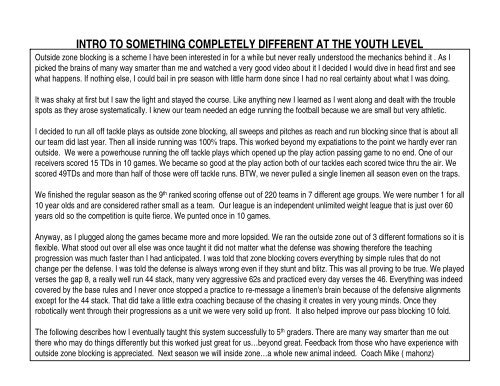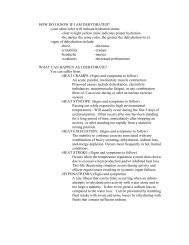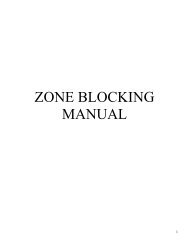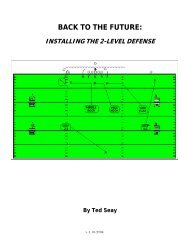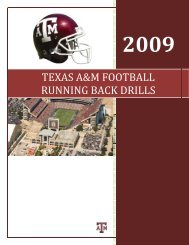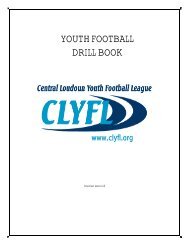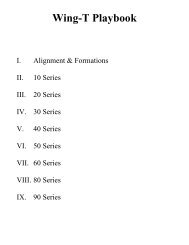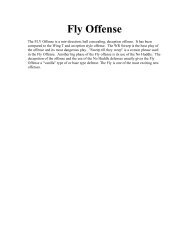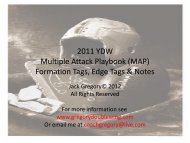Zone Blocking for Youth Football - Gregory Double Wing
Zone Blocking for Youth Football - Gregory Double Wing
Zone Blocking for Youth Football - Gregory Double Wing
Create successful ePaper yourself
Turn your PDF publications into a flip-book with our unique Google optimized e-Paper software.
INTRO TO SOMETHING COMPLETELY DIFFERENT AT THE YOUTH LEVELOutside zone blocking is a scheme I have been interested in <strong>for</strong> a while but never really understood the mechanics behind it . As Ipicked the brains of many way smarter than me and watched a very good video about it I decided I would dive in head first and seewhat happens. If nothing else, I could bail in pre season with little harm done since I had no real certainty about what I was doing.It was shaky at first but I saw the light and stayed the course. Like anything new I learned as I went along and dealt with the troublespots as they arose systematically. I knew our team needed an edge running the football because we are small but very athletic.I decided to run all off tackle plays as outside zone blocking, all sweeps and pitches as reach and run blocking since that is about allour team did last year. Then all inside running was 100% traps. This worked beyond my expatiations to the point we hardly ever ranoutside. We were a powerhouse running the off tackle plays which opened up the play action passing game to no end. One of ourreceivers scored 15 TDs in 10 games. We became so good at the play action both of our tackles each scored twice thru the air. Wescored 49TDs and more than half of those were off tackle runs. BTW, we never pulled a single linemen all season even on the traps.We finished the regular season as the 9 th ranked scoring offense out of 220 teams in 7 different age groups. We were number 1 <strong>for</strong> all10 year olds and are considered rather small as a team. Our league is an independent unlimited weight league that is just over 60years old so the competition is quite fierce. We punted once in 10 games.Anyway, as I plugged along the games became more and more lopsided. We ran the outside zone out of 3 different <strong>for</strong>mations so it isflexible. What stood out over all else was once taught it did not matter what the defense was showing there<strong>for</strong>e the teachingprogression was much faster than I had anticipated. I was told that zone blocking covers everything by simple rules that do notchange per the defense. I was told the defense is always wrong even if they stunt and blitz. This was all proving to be true. We playedverses the gap 8, a really well run 44 stack, many very aggressive 62s and practiced every day verses the 46. Everything was indeedcovered by the base rules and I never once stopped a practice to re-message a linemen's brain because of the defensive alignmentsexcept <strong>for</strong> the 44 stack. That did take a little extra coaching because of the chasing it creates in very young minds. Once theyrobotically went through their progressions as a unit we were very solid up front. It also helped improve our pass blocking 10 fold.The following describes how I eventually taught this system successfully to 5 th graders. There are many way smarter than me outthere who may do things differently but this worked just great <strong>for</strong> us…beyond great. Feedback from those who have experience withoutside zone blocking is appreciated. Next season we will inside zone…a whole new animal indeed. Coach Mike ( mahonz)
THE RULES-There is only one rule to outside zone blocking….determine whether you are covered or uncovered be<strong>for</strong>e the football is snapped.-If uncovered then you will slide step play side and attempt to take over the block of the next man over play side attacking the farfunnel of the defender and getting your butt to the football bumping the next man over play side off his block. The funnel is the areafrom the center of the chest plate up to the shoulder and down to the elbow. Hitting a perfect funnel is right into the armpit.-If covered then you will t-step through the defenders play side number standing him up and turning him slightly so he is facing thefootball. Then attempting to block a scraping linebacker once the backside next man over bumps you off your block-Uncovered means there is no defender aligned over you or fully in your gap to the play side. Ignore backside gap unless that man isalso uncovered. Basically if no defender is shading your pads your are uncovered.-Covered means there is a defender aligned right over you or fully in your play side gap. Must always pay attention to the backsidegap. Basically if a defender is shading your pads anywhere you are covered.-If uncovered and a linebacker walks up over you then you are now covered even if you don’t think you are.If he is on the line andanywhere near you then you are covered. If you are now covered then it is possible you will get help from the next man over backsideif he is uncovered.-If covered and a linebacker walks up into either your backside gap or the play side gap you are still covered. It is up to the next manover either way to pick him up but you will no longer get any help and will not release to a linebacker.- If uncovered and the d-lineman attacks hard to the backside gap then he is that uncovered mans immediate block without having tobump the next man over off play side as the covered man will now be immediately rotating to a scraping linebacker.-If covered and the d-lineman attacks hard to the play side gap then the covered man is alone on the block and the uncovered mannext to him backside immediately rotates to a scraping linebacker.-Any late shift by the D-line could or will change the rules of being covered or uncovered.-All linemen could be considered covered all at once but never all uncovered…that would be a stupid defense.-If the d-line ever runs a twist then the vacating d-linemen is not your problem if he goes backside but the one about to show up isyour problem. Same holds true with stacking and stunting linebackers. Who ever shows first is your man as you take the first zonestep as determined by your pre snap rule. Never chase a stunt. Run your steps by rule and the stunt will get caught up somewhere intraffic. The rules hold true <strong>for</strong> all down blockers EMOL to EMOL.-Fast feet, fast hands, fast eyes all come after a fast brain. Think first then do and be<strong>for</strong>e long you can do without thinking. If wrongthen fix it the next play but never hang your head. Have a short memory and talk it over with your buddy on the way back to thehuddle. Troubleshoot your tandem on the field per the defense. The coaches can only emulate so much <strong>for</strong> you during practice. Playfootball and figure out the tendencies of the defense. They can only do so much and eventually you will know what that is…exactly.
We go through thisprogression each day <strong>for</strong> 10minutes, birddog to full speed.T STEP WHEN COVEREDPlay side foot is the first step and is equal both vertical and horizontal depending on yourplayer. 6x6 or 8x8 or 10x10. This foot then plants and sets <strong>for</strong> the third step. Both handscock and aim <strong>for</strong> the defenders far number. Thumbs up palms out. Stay low until handsengage. Then drop hips and lift hard during the power step.Back side foot is the second step and is the power step long and hard into the defenderscrotch. It is important the power step is straight away and stays underneath the shouldersof the blocker. This step then plants and sets <strong>for</strong> the fourth step while maintaining a goodbase. The hands power into the defenders far number as hard as possible turning himand standing him up. Keep shoulders square.Third step resets the blockers base as he waits <strong>for</strong> the take over move by thenext man over while maintaining a good base. Blocker collapses into the thedefender and waits <strong>for</strong> the next man to bump him off. He must not leave untilhe is bumped. Standing up the defender is critical as you roll the butt to thefootball. As he waits he spies the second level.Fourth and fifth steps slides off the block whilemaintaining a good base. Up field foot is first.Find and get on linebacker.1 2 3Path of the football
HOW IT LOOKSUCCUCCUCC123Path of the footballDirection the entire zone is rotating.
WHAT IF FOR THE D-LINEPath of the footballUCCUCCDirection the entire zone is rotating.The defender goes hard into the covered mansplay side gap. Then the covered man gets bothhands on the backside numbers and takes theblock on alone riding the defender hard on hisnatural path. The uncovered man then getsimmediately to the linebackers. Steps do notchange.The defender goes hard into the uncovered man.Then the covered man gets both hands on thedefenders play side hip and pushes off to thelinebacker immediately. This actually helps theuncovered man take over. Steps do not changeUCCWe teach the linemen to key the defenders helmet ifin a 3 or 4 point stance, the belt buckle if in a 2 pointstance. This tells the linemen immediately where thedefender is going. Eyes are not down field untilengaged with the first level defender. If a defenderbear crawls then which ever linemen meets him firstfall on him so his buddy can continue to thelinebacker. The footwork and the hands must befast…fast …fast and stay as square to the LOS aspossible until you begin to rotate in tandem.The defender goes hard into the covered man.Then all rules apply and they run the defenderuntil the uncovered man bumps the covered manoff. Then the uncovered man rolls to thelinebackers. Steps do not change.
WHAT IF FOR THE LINEBACKERSPath of the footballUCCUCCDirection the entire zone is rotating.The linebacker walks up and fills the coveredmans play side gap. Then both blockers slidestep into their defenders. Neither lineman willrelease to the second level and both blocksbecome big on big getting their butts to thefootball. A big power step is critical when notgetting any help.The linebacker walks up and covers the uncovered man.Then both blockers t-step into both defenders. Neitherlineman will release to the second level and both blocksbecome big on big getting their butts to the football. A bigpower step is critical when not getting any help.UCCThe linebacker zone blitzes backside or play side. This actually helps the scheme since the d-linemen will attempt to shoot a gap and pull the double team. The rules don’t change as theblockers are attempting to block the linebacker anyway. If the blitz comes backside then thecovered man takes the d-line by rule because the d-lineman goes hard to the play side gapand the uncovered man picks up the blitz. If the blitz comes play side then then the coveredman picks up the blitz because the d-lineman goes hard backside and the uncovered mantakes the d-line. If the blitz is a jailbreak up on the line then all blockers t-step into thejailbreak. If the jailbreak is all zone then the blockers play by rule depending on the immediateaction of the d-line. That is why we do teach eyes on the d-line first….then down field.
Whether cover or uncovered, tstepping or slide stepping thesteps are always TOWARDSthe football. The ball carrier willalways run WITH the flow ofthe line not against until he hitshis monument. See page 14.In other words the zone willALWAYS rotate to the football.THE LINE RULES vrs. BASE 5-3Path of the footballUncovered then slide stepCovered then T step93 039Direction the entire zone is rotating.
T-STEP MAT DRILLS w/ LIMBO BARLimbo bar<strong>Blocking</strong> dummyadded laterRubber industrial kitchen mats ripped into 6 inch strips 3 feet long. These can bepurchased at any Home Depot in 3 foot by 6 foot sections. These work great ingrass and will grab lazy feet without tripping the players.We use a limbo bar that is set 12 inches over the linemen’s facemask. They cannot touch the limbo bar as they come out of theirstance. Both heels must touch the horizontal mat with the play side foot touching the vertical mat. On the coaches whistle they t-stepunder the bar. It is very difficult to keep the second step which is the power step underneath their bodies at first. Stress that they do.Shown is practicing a t-step to the left. Move the vertical mats to the right to practice going right. The first step is across and to the farside of the vertical mat and <strong>for</strong>ward equal distance. The second step is to the same side of the vertical mat and long to the end of themat. As they get com<strong>for</strong>table with their steps under the bar add a bag to hit into with a piece of tape marking the aiming point ( nearnumber). They need to power up the hands on the first step and get the palms out thumbs up. Stress quick feet and good hands andpower into the tape collapsing hard into the bag while he lifts keeping his hands on the tape. <strong>Zone</strong> blocking is susceptible to holdingcalls. Stress hands inside, aim, collapse and lift. We do this drill <strong>for</strong> 5 minutes each direction and eventually use the bags full time.
SLIDE STEP MAT DRILLS w/ LIMBO BARLimbo bar<strong>Blocking</strong> dummyadded laterRubber industrial kitchen mats ripped into 6 inch strips 3 feet long. These can bepurchased at any Home Depot in 3 foot by 6 foot sections. These work great ingrass and will grab lazy feet without tripping the players.We use a limbo bar that is set 12 inches over the linemen’s facemask. They cannot touch the limbo bar as they come out of theirstance. Both heels must touch the horizontal mat with the play side foot touching the vertical mat. On the coaches whistle they slidestep parallel to the bar. Shown is practicing a slide step to the left. Move the vertical mats to the right to practice going right. The firststep is across and to the far side of the vertical mat parallel with the bar. The second step is to the same side of the vertical mat andparallel to the bar and is the same distance as the first step to maintain a good base. The third step is the power step along the farside of the mat and to the end of the mat. As they get com<strong>for</strong>table with their steps under the bar add a bag to hit into with a piece oftape marking the aiming point ( far funnel ). They need to power up the hands on the first step and get the palms out thumbs up.Stress quick feet and good hands and power into the tape collapsing hard into the bag while he lifts keeping his hands on the tape.<strong>Zone</strong> blocking is susceptible to holding calls. Stress hands inside, aim, collapse and lift. We do this drill <strong>for</strong> 5 minutes each directionand eventually use the bags full time. This drill will also dictate your horizontal splits. If the first step steps on the next mans eventualsecond step foot then the splits are too close or you may want to use the bucket step instead of the slide step if using tight splits.
UCCTHREE MAN DRILLS w/ LIMBO BARUCCUCCLimbo bar1 23We use a limbo bar that is set 12 inches over the linemen’s helmet. They cannot touch the limbo bar as they come out of their stance.This <strong>for</strong>ces them to stay low until they lift the defender on their power steps. The lift is critical to the block so that it takes the poweraway from the defender as the blockers rotate. We allow the blockers complete success at first. Whether you use a live defender or acoach with a shield the blockers must be allowed success as they get used to rotating and lifting. We basically tell the defender hewill allow the blockers to kick his butt then as the blockers get com<strong>for</strong>table they add resistance. We birddog this through all 4 majorsteps then go live. Coach checks, steps hands and eyes. The defender is eventually allowed to attack any gap after the blockers gettheir bearings. At figure 1 all 3 players should be in their stance and by figure 3 nearly upright. This is not a stay low and drive block. Itis stay low then lift block. Very important difference is vision to the second level. The blockers want to emphasize the hard punchwith hands and the lift while they collapse into the defender. The lift and drive has to be powerful enough that if they did it on air theywould face plant into the turf. We do this drill every day <strong>for</strong> 10 minutes with 2 blockers on one defender. As the blockers getcom<strong>for</strong>table we will add a scraping linebacker to the drill <strong>for</strong> the next 10 minutes but we progress the same every day. At first <strong>for</strong> thefootwork we spray paint white dots in the grass <strong>for</strong> them to follow.
3 SECOND COMPETITION DRILLWe set up two teams <strong>for</strong> this drill andcrown winners. The two blockers mustexecute the perfect zone technique per thecoaches set rotation( left or right) andthen the proper blocker must release andthen drive the bag on its side with hishands only <strong>for</strong> 3 full seconds. Whoeverdrives the gag the furthest in 3 secondwins. If the wrong blocker releases thatteam is disqualified. What his does istrains the blockers not to release early butto at least release and who is supposed torelease. The coach holding the bag willdictate who releases by how he attacksthe tandem with his bag and who hecovers. This also trains both blocker tomaintain their blocks no matter what <strong>for</strong> 5full seconds without paying any attentionto their buddy after they release. Duringthis drill you want to really train the eyes. Itis difficult to read to the second level whileengaged in a block so we use this drill tostress the eyes on the bag since it isstationary. We found that stressing theeyes only confused them as they learnedthe steps and the punch. Once theyrelease they will hit something so this drillalso helps out with that aspect.<strong>Blocking</strong> dummy heldby coach<strong>Blocking</strong> dummy onend 3 yards away.We do this drill twice a week<strong>for</strong> 10 minutes.
5 SECOND COMPETITION DRILLWe set up two teams <strong>for</strong> this drill andcrown winners. The blockers must executethe perfect zone technique per thecoaches set rotation( left or right) andinstruction ( covered or uncovered) Thenthey both execute their pre determinedrule and immediately release to drive thebag with their hands only <strong>for</strong> 5 fullseconds. Whoever drives the bag thefurthest in 5 second wins. What this doesis trains the blockers to execute their stepsand get downfield as fast as possible inthe case they have no one to block. Thisalso trains both blocker to maintain theirblocks no matter what <strong>for</strong> 5 full secondswithout turning around to see where theball is in the case they have no one toblock. We stress there is always anothervictim downfield and every play in footballwill last about 6 seconds. This drill is verygood at getting blockers downfield. We allknow what typically happens if a youngman does not have someone to block. Youcan add the limbo bar to this drill if youwant to stress staying low but we stress ifyou fire off and land on air get verticalimmediately and hit something…anything.<strong>Blocking</strong> dummy onend 3 yards away.We do this drill twice a week<strong>for</strong> 10 minutes.
Direction the zone rotatesTEACHING THE RUNNING BACKSPath of the football93 039We teach the backs to fill the tackles pre snap shoes no matter what. If running right RT, left LT and this is not negotiable with them.Once they fill those shoes then they have 3 options. 1- Continue the path 2- cut outside once 3- cut inside once. No dancing bouncingor delay of any kind. Your are a missile to the tackle then one cut and go. In the above diagram all 3 possibilities are there. IF the DTattacks the B gap then the LT at the point of attack can easily get on the play side OLB at a good angle and the running back can gostraight away or cut outside. IF the DT attacks the C gap then the LG will not get on the play side OLB at a good angle there<strong>for</strong>e theback must cut back inside. If the POA is clogged the back still finds whatever seam he can and takes it. If he comes in like a missilehe will gain a little something through the seam or get caught up into the flow of the zone and and pop out the other end. No matterwhere the back starts in <strong>for</strong>mation he must fill the tackles shoes first. The back must start rather deep if it is a straight handoff ordelay if it is a cross buck or wrap around from the backside. Either way the line must have some time to engage and begin to run androtate the defense be<strong>for</strong>e the back arrives. The more times you run this play in a row during the games the better it gets. There areonly a few things the defense can do defending the off tackle and they are all covered by rule so its just a matter of allowing yourplayers to get com<strong>for</strong>table and execute. There is not a designed hole but rather a monument. The play side tackles feet pre snap isthe monument. From there the play now has options and can take on a life its own and those options are dependent on the defense.
DRILLING THE RUNNING BACKSRunning back 6 yardsdeep.QB practice opening up andhanding off then boot away.<strong>Blocking</strong> dummiesstanding uprightCoaches with handshields 3 yards deep.We tried a few things but this was the best. The running back would run in-between 4 upright blocking dummies split 2 by 2 andtouching one another. This would take his downfield vision away. Then 3 coaches or players holding shields would wait on the otherside 3 yards deep and spread 3 yards apart. As the runner came through the hole one of the three shields would attack him so hewould have to quickly think and make his cut or stay the path. This really helped as the season progressed and we ran this drill <strong>for</strong> 20minutes at a time using 5 backs and 2 QB’s. The shields could not attack until the runner was completely in the hole since most of ourplayers were shorter than the bags so they came out blind. It was very apparent this drill worked when we went team. The cuts werecrisp and very quick or when he would stay on path and would beat the scrape. Back aligns 6 yards deep and behind the center. TheQB would practice handing off and booting away while he RB took a proper handoff. The drill easily flipped to go to the right and left.
TROUBLE SPOTS AND THOUGHTS … DON’T FORGET I AM A ROOKIE WITH THIS STUFF- Do not lead a back through the zone. They just get in the way.You can use the FB or WB to mesh to kick out or to log at theperimeter but to isolate a backer with a back gets messy.- Slow lumpy linemen do not work. The linemen have to beathletic and use quick excellent technique. Fast feet and fasthands are a must.-- The stance we use is a bit unique. Heels even with oneanother, butt low, head up, back straight, 80% of the weight onthe balls of the feet 20% on the down hand. This allowed <strong>for</strong>good vision and quick lateral movement. The feet are under eacharmpit so the stance is rather skinny with the knees slightly out.Like a frog leaping out of his stance.-- Vertical splits are maximum, horizontal splits depends on yourscheme or if you use slide in lieu of bucket steps. We use slide.-- In order <strong>for</strong> the outside zone to work the defense must run withor flow with the play. At the youth level some will and some willnot. If you run the outside zone enough the defense will begin toflow with you. You almost have to train them <strong>for</strong> what you wantthem to do sometimes. If they don’t flow then the zone getsclogged and the back will want to bounce. Like a lot of things inyouth football, if the defense does not play sound rules then thatalone can blow up your plays. If that happens run traps all day orinside zone ( have not taught IZ yet so cant comment ). Trapsare the perfect option <strong>for</strong> kids that sit and wait. OZ is the perfectoption <strong>for</strong> defenses that flow and attack….like most will.-- Linemen will have a hard time releasing off the doubleteam…or both releasing and leaving the DL untouched. Bepatient and keep drilling them. It takes time but when it starts tohappen it’s a beautiful thing.- The linemen have to know one another and how each manthinks. Since each zone play is a 3 man tandem working as oneunit they must trust one another.- You can delete the hole numbering system. We created zonesand that told the line how to block. <strong>Zone</strong>s 3 and 4 was <strong>for</strong> allsweeps or the quick toss outside the TE. 1 and 2 were all OZ offtackle plays and 0 was <strong>for</strong> all traps. For pass blocking they wouldkey the call. All calls ending in a digit was a run to that zone, allplays ending in a letter was a pass.-- We ran OZ off tackle plays out of 3 <strong>for</strong>mations. An ace backwith the back at 6 yards, the wing t with the full back at 6 yardsand the HB at 3 and the I with the FB at 4 and the TB at 6 yards.We ran an OZ to the wing t HB as he wrapped the QB afterfaking the FB dive, then he would turn immediately up field offtackle so you can do just about anything as long as the backdoes not arrive at his monument too early. The ace <strong>for</strong>mationwas the best with 2 TE’s and 2 slots split wide. The QB actionwas easiest in ace. Anything else will take some extra reps.Keeping the QB on his midline in the wing t took some time.-- The boots and waggles off the OZ is very nice. Especially onceyou get the defense running with you.- You no longer have to rely on the sweep. Most youth defenses<strong>for</strong>tify the perimeter since the sweep is king with the little guys. Ifyou can effectively run the c gaps all day regardless of thedefense you are now running a contrarian offense <strong>for</strong> youths. Weran sweeps and pitches on rare occasion.-- The kids think its cool because no one else does it. We toldthem they were running a big boys offense. That peaked interest.It is important the kids enjoy what they are learning.
BONUS -SLIDE PROTECTION FOR THE DROP BACK PASSNow that your line are the masters of the slide step simply slide protect your pass plays. You can go all left or all right. It is real tough<strong>for</strong> the defense to pick up TE’s on the slide protect since they release late. The RB has to banana to the unblocked DE. Take twosteps towards your run monument then stop and wait <strong>for</strong> the DE then at the last minute scoop him to the sidelines. No play action.Straight 3 or 5 step drop. Really tough to beat this simple scheme. It builds a great wall as the front side OT picks up the front sideDE. Teams know we will pass and it still works great. Linemen implement their slide steps and then start running in place andpunching at the ugly #s in front of them while always protecting from the football out. It is so similar to OZ you never telegraph pass.Works against all fronts. Slots go deep and the TE’s shallow to medium. Slots can be minimum type player positions with purpose.
BONUS -KICK PROTECTION FOR THE PLAY ACTION PASSSimply do the same <strong>for</strong> the slide protection except keep the play action side TE in to block and have the backside TE and OT switchdefenders. The TE cracks the DT <strong>for</strong> one second then literally pushes off him catapulting himself into into a quick arrow route. QBplay actions to the RB and throws quick to a 100% wide open TE ahead of the OLB. Slot receiver runs a slant to clear the zone.Never had an incompletion all year running this play to either TE both left and right. Backside OT bucket steps and rides the DE out.Play action side DE is a non issue. Works against all fronts.


